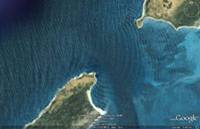Diffraction
Diffraction is the bending of waves around an obstacle or through an opening as seen in the image below.

 Click on image to enlarge.
Click on image to enlarge.
Map Data © 2009 Google, MapData Sciences Pty Ltd PSMA, Cnes/ Spot Image and Europa Technologies.
Diffraction is more obvious when it occurs with light waves rather than mechanical waves because the effects are usually brightly coloured (eg rainbow-like colours seen on a CD) or large scale (eg halos in the sky centred on the sun or moon). In this section we shall consider diffraction as it occurs for sound and ocean waves.
Diffraction is not as common a wave behaviour as reflection and refraction because it involves a specific set of conditions.
The amount of diffraction depends on the wavelength of a wave, and the width of an obstacle or opening with which the wave, interacts.
To discover the relationship try this activity.
- Select the wavelength of the waves using the wavelength dial.
- Select the width of the opening using the width dial.

1 |
When the width of the opening is fixed and the wavelength of the waves is decreased, describe what happens to the amount of diffraction. The diffraction is: |
2 |
The diffraction is most noticeable when the width of the opening is: |
3 |
High frequency sound waves have a smaller wavelength than low frequency sounds. If you listen to traffic sounds from vehicles on a nearby road, how does this compare to the noise level when you are positioned along a side street, next to a tall building facing the road? |

Noise from vehicle traffic along freeways and highways through urban centres is minimised thanks to constructed sound barriers. Although these barriers provide a direct blocking action to road noise, they are principally designed to minimise diffracted sound. Road noise peaks in intensity at a frequency of about 1000 Hz ( ≈ 0.34 m) mainly due to the contribution of tyres rolling over the road surface. Barriers with heights much greater than this wavelength can markedly reduce any diffracted sound at this or smaller wavelengths. Larger wavelength noise diffracted over the barriers is minimised by incorporating design features on the top edge of barriers, such as angled extensions.
≈ 0.34 m) mainly due to the contribution of tyres rolling over the road surface. Barriers with heights much greater than this wavelength can markedly reduce any diffracted sound at this or smaller wavelengths. Larger wavelength noise diffracted over the barriers is minimised by incorporating design features on the top edge of barriers, such as angled extensions.

Your ability to locate someone talking in an open space, without first seeing him or her, is somewhat dependent on diffraction. Try placing your hand over one ear, closing your eyes and mentally locating the source of a sound. Now keep your eyes closed and remove your hand from your ear. Your head acts as an obstacle around which sound waves with wavelengths much longer than the width of your head diffract around.
This allows your brain to receive sound signals separated in time, and different in amplitude and in their range of frequencies. Your brain detects the lack of higher frequencies received by your ear further away from the sound and uses this information, and particularly the amplitude and time differences, to estimate the position of the sound source.

You may wish to consider the following as a group.
- How is diffraction different to refraction?
- In general, what should be done to maximise diffraction?
- Explain how diffraction is involved with hearing music at a rock concert.






